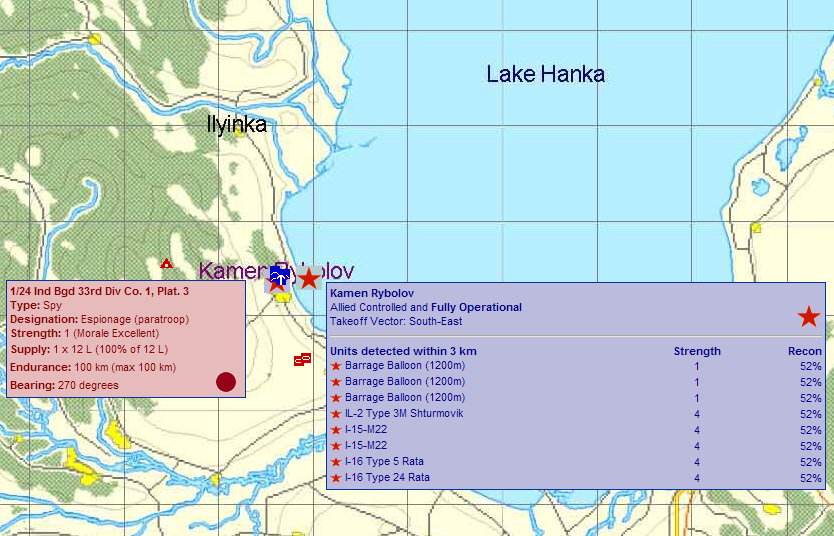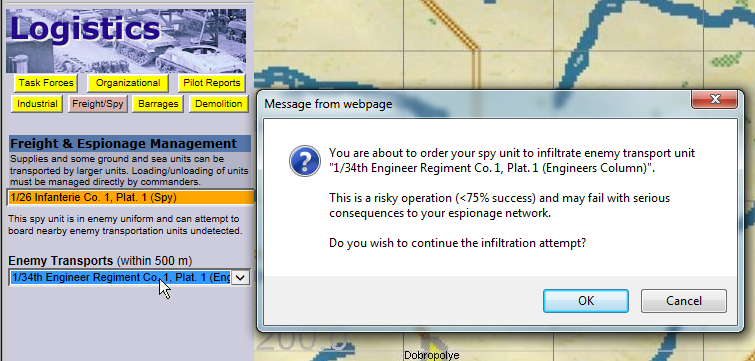Spy Units
With SEOW v3.2, spy units have been introduced to the order of battle for the first time. Any vehicle object can be class as a spy unit (object class "VSP"), but by default the Bicycle object is used as the sole spy type. In a nutshell, spies are used to gather recon information. With the arrival of SEOW7, the spy model has been completely revised to provide much more interaction between the commander and the hard-working spy.
SEOW7 Espionage Model
Much is new in SEOW7, including the advanced espionage model. The fundamental change in espionage is that the spy can assume different disguises, which can affect its lifespan in game. Let us consider the general spy characteristics.
Spy Icons
The icons used to denote spy units have not changed.



Allied Spy icons



Axis Spy icons
Mobility
All spies will move with Simple Mode of the SEOW Complex Ground Movement Model. This means that they will ignore roads, bridges, rivers and forests and will move in a straight line between waypoints. Although they move slowly, they can go anywhere.
Recon Acuity
All spies have excellent eyesight, which means extended reconnaissance detection ranges. They gather information on all enemy units and industrial facilities up to many kilometres distance. The actual scale is determined by the Spy_Scale field in the Sector_Recon_Parameters table. By default this number is 3 or 4, meaning 3 or 4 times the Control Radius or more. You can place a spy in a forest about 10 km away from an industrial centre and it will return growing amounts of recon information over the following missions, depending on the recon decay setting for industrial infrastructure.
Recon Avoidance
Spies are hard to find, and are invisible to air recon photos, so you just cannot send aircraft out taking heaps of photos to find enemy spies - that will not work. On the ground, enemy combat units need to get very close to a spy (less than 200 m) to detect it in the recon sense. Enemy political units (staff cars etc) are better at finding spies, but still they need to get within 500 m or so. The political unit types are hard-coded in SEOW v3.2. They are the following objects: Bicycle, OpelKadett, GAZ_M1, VW82, VW82t,WillisMB, WillisMBt, WillisMBtc_US, WillisMBt_US, WillisMB_US, Kurogane, Limosine, BlueCar, BeigeCar, Voit2P_Beige, Voit2P_Blue. Basically the idea is to set a spy to catch a spy.
Spies are Self-Sufficient
Spies will expertly steal supplies from enemy fuel dumps and supply drops. Once located properly close to supply resources and near airbases or other places of activity, they will provide a steady stream of recon information unless detected and killed by the enemy.
Spies are Paratroopers
Spies are able to be deployed as paratroop units. That is they can be dropped from air transports behind enemy lines, or can be flown in on glider missions. They can also simply ride into enemy territory using their excellent mobility in rugged terrain to avoid discovery.
Spy Production
Spies, like all other units, can be made through industrial effort and commissioned as reinforcements in the usual way.
Spies are Easy to Kill
Spies, as bicycle units, are quite defenseless and are easy to kill once discovered. They can even be "caught and killed" by enemy units if the enemy units happen move within engagement range and open fire. For this reason, never place your spy near a road that enemy troops may use. Keep them out of harm's way. Spies are never captured alive and are thus never interrogated, except in the course of catastrophic detection+liquidation events (see Risks and Consequences below).
Spy Disguises
SEOW7 allows spies to change clothes! Simply click on the spy in the Mission Planner, right-click and select "Toggle Spy Disguise". The current spy disguise is listed in the spy unit tooltip. There is no different skin applied to the spy object in game - disguises are virtual.
Plain Clothes
New in SEOW7, spies are in plain clothes by default. This means:
- they appear as neutral objects in-game if stationary (i.e. neither Red nor Blue units will pay any attention to it in game)
- they appear as national objects in-game if mobile (i.e. a Red spy will have red colour in-game, and may be targeted and shot on sight by Blue units)
Enemy Uniform
Spies may be ordered to change into enemy uniform at any time. This has the following effects:
- The spy's unit tooltip background is coloured orange
- The spy will appear in enemy colours if mobile or stationary (i.e. friendly units may mistake it for an enemy and shoot at it in game)
- The spy may disappear from view in the Mission Planner for several missions in a row, simulating the difficulty of communication whilst in deep cover.
- The spy may be ordered to board (infiltrate) enemy transport units as undetected freight (Logistics:Freight/Spy tool).
- The spy may be ordered to disembark (exfiltrate) enemy transport units and provide recon on the enemy transport unit and freight (Logistics:Freight/Spy tool).
Risks and Consequences of Spy Actions
Spies can be involved in several risky actions: Disguises, Infiltrations and Exfiltrations.
- Changing disguises carries serious risks to the spy and to all other friendly spies. Changes of disguises fail with a probability connected to the spy skill. The more skilled the spy, the greater the chance of success. This risk applies no matter whether the spy is in friendly or enemy held territory.
- Infiltrations and Exfiltrations are also risky, but in this case the skill of the enemy transport unit is also involved. It is harder to board an Ace enemy transporter with a Rookie spy than to board a Rookie transporter with an Ace spy.
In all spy actions, the commander is provided with an estimate of the success probability before the final decision to proceed is made. If the commander decides to proceed, there is no turning back.
- Consequences of failure are significant. First, the spy is immediately captured and interrogated. This will result in all friendly spies in the map having their recon values added by a random exposure increment up to 30%. Then the spy is executed and dumped. This whole process is called liquidation. Any spies who are exposed by the interrogation are themselves liquidated. It is possible (but unlikely) for liquidation of one spy to set in train a cascade of liquidations, leading to immediate exposure and liquidation of an entire spy network across a map.
- Routine Exposure Risks are always an issue. As a spy moves through enemy territory, regardless of disguise, it may be detected by enemy units and have its recon level increase. If the recon level rises above 80%, the spy may be exposed and liquidated at any time. Since no spy or commander is aware of how much recon the enemy has, routine exposure can happen without warning. Recon declines if the spy keeps moving or is hidden well away from enemy units.
Examples
Conventional Spy Use
Here is a graphical example of conventional SEOW spy placement to support an armoured assault. The Japanese forces have placed a spy west of Kamen Rybolov in the Lake Hanka region of the Manchuria sector. Over time the spy has collected 52% recon on the local Soviet controlled airbases, showing that there is no serious ground defence (only some barrage balloons). The base should be easy to capture if the approaching Japanese tanks to the south can move swiftly and destroy the balloon units before the enemy IL-2s can intervene. Twenty enemy aircraft could be captured!

Advanced Espionage
An example of spy infiltration in the SEOW7 advanced espionage model. Here near Stalino in the Donbass sector we have German spy attached to 26 Infanterie Division but wearing Soviet army uniform. The spy is close to a supply column of the Soviet 34th Engineer Regiment, and has the opportunity to attempt infiltration of the supply column. The commander faces the choice of taking on the risk of failure. If successful, the spy may stay with the supply column as undetected freight, travelling wherever the column goes, as ordered by Soviet commanders. Intermittently the spy will re-establish contact with German Command, allowing the German commander to order an exfiltration attempt. It is the commander's responsibility to keep a careful watch for the spy from mission to mission, awaiting contact.

Programming Spies
The spy's scouting function is dependent upon the object class "VSP". You can make any vehicle a VSP class unit by editing the Object_Specifications table. Also note that the extended recon range for VSP class units is governed by the Spy_Scale field of the Sector_Recon_Parameters table. The larger that value, the longer the range that spies can gather recon over.